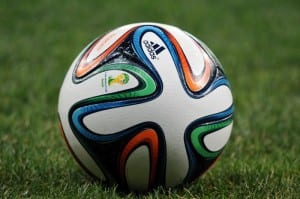 China may have failed to qualify for Brazil, but China’s manufacturing is certainly on a winning streak.
China may have failed to qualify for Brazil, but China’s manufacturing is certainly on a winning streak.
World Cup winning commodity manufacturing
Exports of sports-related items from Yiwu, the centre of China manufacturing and wholesale for commodities, to Brazil are up 42 percent on last year. That’s a total of US$2.78 million. Then you can add the value of goods sold to other participating countries.
One example is the caxirola, the official musical instrument of this World Cup. An estimated 90 percent of caxirolas worldwide are made in Zhejiang and Guangdong. What’s more, the profit margin is nearly double that of the vuvuvelas which were produced for the 2010 South African World Cup.
Meanwhile, workers in Jinhua City have been producing millions of national flags They’ve been sold to all the competing nations, including favorites Brazil, Germany, Spain and Argentina.
Li Meihua manages one flag factory, where over 200 women work night and day. She watches the 2014 FIFA World Cup every midnight so she knows which flags will be most in demand. As soon as a team enters the top eight, more flags will be needed.
Then there’s the FIFA mascot Fuleco. This three-banded armadillo is native to Brazil, but threatened by hunting and loss of habitat.
 Kayford Holdings Ltd, a Chinese company headquartered in Hong Kong, is the only licensee outside Brazil. It has designed nearly 100 different products based on the mascot. In the last 13 months, over 1 million Fulecos – ranging from 20cm to 2 metres tall – have been produced in Anhui and sold to 39 countries.
Kayford Holdings Ltd, a Chinese company headquartered in Hong Kong, is the only licensee outside Brazil. It has designed nearly 100 different products based on the mascot. In the last 13 months, over 1 million Fulecos – ranging from 20cm to 2 metres tall – have been produced in Anhui and sold to 39 countries.
Chief Sales Manager Huang Kunlun says, “What we feel most proud of is that no quality complaints have been received. ‘Made-in-China’ is no longer a synonym for low-end products of poor quality.”
The story of the ‘Brazuca’ 2014 FIFA World Cup ball also shows how China manufacturing is changing. It was developed by Longway, a company based in Shenzhen, Guangdong. They worked with Adidas to create the ball, which is radically different from the ball used in South Africa. With an estimated global requirement for 40 million balls or more, Longway were unable to guarantee sufficient supply. So manufacturing was lost to Pakistan. In this case China was part of the value-added design process, but not the final manufacturing.
China manufacturing includes infrastructure and hi-tech
Nor is China manufacturing all about commodities – Chinese manufacturers are also significant in tournament infrastructure.
Yingli Solar from Hebei is the only Chinese company to be an official sponsor of the World Cup. It has provided 27 sets of photovoltaic systems to cities hosting World Cup games. It has also installed solar stations in six stadiums, for reporters to recharge their phones and computers.
Aoto Electronics in Shenzhen won a 7 million yuan (US$1,125,000) contract to supply the LED screens in most stadiums.
600 security systems from Beijing-based Nuctech Company have been installed in eight stadiums.
In host city Curitiba, hybrid buses from a Chinese manufacturer offer transport between the airport and downtown.
China manufacturing is dominant on a global scale, across a range of industries and technologies.
But what about the soccer?
Even with their own team missing, the World Cup has been a huge hit in China. Time difference means matches are played in the middle of the night, and many are staying up late to watch. Some managers have noticed a drop in productivity. A few factories have even adjusted working hours to let workers recover. And there’s been a massive spike in the sales of fake sick notes as Chinese workers plan to sleep in after long nights watching soccer.
As for who will win the World Cup, none of us know yet and many of us are guessing. Li Meihua’s prediction is based on flag orders at her factory. She currently puts Germany first as their flag is the largest order, followed by Spain, then host country Brazil.
Will she be right?
Does she care? For many, the World Cup is more about business than soccer. Li estimates she has made around US$1.3 million from the global event. On a smaller scale, as one of her workers said, “We have to work late but we earn more money and then I can rebuild my house.
[Edit July 14th: So Li Meihua got her predictions right! Then again, she had three chances to pick the winner, so maybe it’s not that surprising.]
